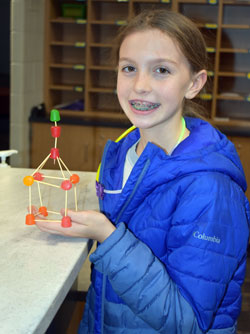Godwin Heights — Fifth-graders Caiden Dorman and Cornelius Weed debated whether a gun-shaped device that reduces the size of items was practical in helping students carry the items they need for school.
“I think, with the shrink ray, the school may consider it a weapon so I feel we should cross it off our list,” Caiden said.
And so both boys did just that.
Their class was participating in a STEM activity, tasked with developing something that could transport materials/school supplies to and from school.
The students started by exploring the need.
“What do you think fifth-graders will need to transport?” asked teacher Meghan Shannon.
A phone, books, pencils and homework were some of the answers students provided before pairing up, planning their solution and readying to build a prototype.
Teachers First
Earlier in the month, Shannon joined other North Godwin teachers for a training hosted by Kent ISD educators who specialize in science, engineering, technology and math. The teachers were given the same assignment: create a carrier for school supplies.
“The idea is to introduce the teachers on how STEM can be implemented into the classroom,” said Karen Baum, instructional specialist for North Godwin.
The goal is that students will have worked on nine different STEM projects over their three years at the school.
STEM is not new to North Godwin: Such projects are listed at the end of math and science lessons. But North Godwin, which has third- through fifth-graders, is putting more of an engineering focus on its new STEM program.

“By coming through with an engineering lens, we are giving the students the opportunity to see themselves in this type of career,” Baum said. “It also incorporates many of the skills needed for career readiness, such as critical thinking, collaborating with each other, communicating and being creative.”
STEM Night Offers Family Discovery
A family STEM night in November introduced parents and students to STEM programming. Attendees moved from room to room at the school, participating in a range of activities from 3D drawing to creating with glow sticks.
“I like being able to do it, and discovering what they are doing in the classroom,” said Tica Floyd as she worked with her son, Ayden Floyd-Crawford, on a project to design packaging that would keep a potato chip from breaking while traveling.
“This is really a way to keep the students active and engaged in the classroom,” Floyd said.
Test & Improve
Back in Shannon’s classroom, students dug into materials kits provided through a partnership with Gordon Food Service. It was a flurry of activity as students raced against the clock.
“Don’t worry about your project being perfect,” Shannon told them.
Melanie Gonzalez and Libby Buikema made a last-minute change from pom-poms to yarn for decorations on their vending-style carrying case.
“So you put the items in the back and then you press a button to select items that you want, which come out through the front,” Libby explained.
Athena-Marie Dear, who worked with Jaden Ewing on another design, explained theirs: “It is like a backpack but with wheels, and you can drive it.”
The alarm went off and the students brought their projects to the middle of the room for the last part of the STEM process: test/present and receive feedback.
“You put your stuff on the top and on the side, you can work on the wiring,” Caiden said of the “back bot 2000,” the final design he and Cornelius settled on. “You can press the button, and there is a force field that comes up to protect your stuff.”
Cornelius held up a flat, dry sponge and explained, “This is the control that you can use to see what the back bot 2000 is doing and where it is flying.”
Explore more unique video stories of students learning, interesting school programs and educators working to help all children succeed.

















